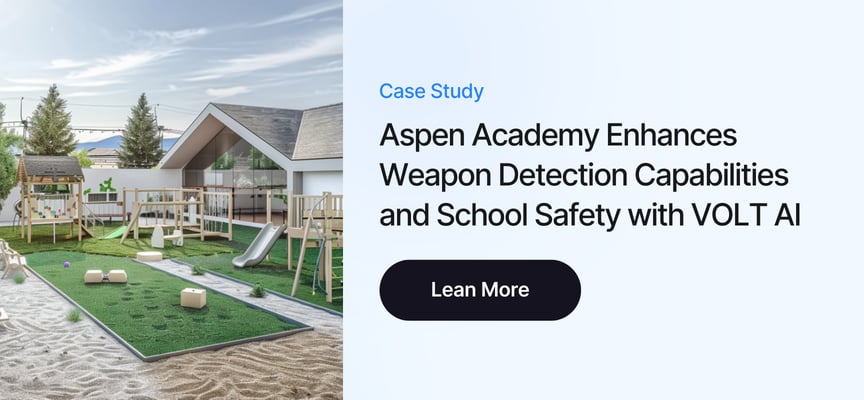Key Takeaways from Live Video Monitoring
- Proactive vs. Reactive Security: Live video monitoring enables threat detection and response in real-time, shifting security from documenting incidents to preventing them.
- Multiple Implementation Models: Organizations can choose between human-operated, AI-assisted, or fully automated monitoring based on their specific needs and resources.
- Active Deterrence Capabilities: Real-time monitoring enables immediate intervention through two-way audio, automated announcements, and other deterrence methods that prevent incidents.
- Integration Is Essential: Effective live monitoring integrates with access control, alarm systems, and emergency notification platforms to create comprehensive security coverage.
- Clear Response Protocols: The effectiveness of monitoring ultimately depends on well-defined procedures that ensure the right people take the right actions when threats are detected.
Traditional security cameras record incidents for later review—but what happens when security teams need to respond to threats as they unfold? This is where live video monitoring transforms security from a passive record-keeping function into an active protection strategy.
Live video monitoring combines real-time video feeds with continuous human or AI-powered observation to detect security threats as they develop. Unlike conventional CCTV that primarily serves as evidence after incidents occur, live monitoring enables immediate intervention that can prevent incidents entirely or significantly reduce their impact.
Let's explore how live video monitoring works, its benefits, and best practices for implementation across different environments.
Read Now: How video monitoring is transforming with AI Powered Intelligence
Understanding Live Video Monitoring Solutions
Live video monitoring comes in three primary forms, each with distinct advantages and applications:

Human-Operated Monitoring
Traditional live monitoring relies on security professionals watching video feeds in real-time from a central station. Operators actively observe multiple screens, looking for suspicious behavior or security threats. When they identify a concern, they can immediately alert on-site security personnel or contact emergency services.
Human monitoring brings experienced judgment to security operations but faces significant limitations. Studies show that operator effectiveness decreases dramatically after just 20 minutes of watching video feeds, and a single operator can effectively monitor only 1-2 screens simultaneously. This creates substantial blind spots in coverage.

AI-Assisted Human Monitoring
This hybrid approach uses artificial intelligence to pre-screen video feeds and alert human operators only when potential security concerns arise. The AI technology continuously analyzes all camera feeds, identifying specific behaviors, objects, or situations that warrant attention.
When the system detects a potential threat, it immediately brings that feed to the operator's attention, allowing them to verify the concern and initiate appropriate response protocols. This significantly expands coverage while minimizing operator fatigue.

Fully Automated AI Monitoring
The most advanced approach uses sophisticated AI algorithms to continuously monitor all camera feeds without requiring constant human observation. These systems detect specific security concerns—weapons, fights, unauthorized access, suspicious behavior patterns—and automatically alert security personnel when verified threats emerge.
Many systems include human verification services that quickly review AI-detected concerns before alerting on-site personnel, virtually eliminating false alarms while maintaining rapid response capabilities.
Visit the full video monitoring resource center
Key Benefits of Live Video Monitoring
Immediate Threat Response
The primary advantage of live monitoring is the ability to respond to security threats in real-time rather than discovering incidents after they occur. When an unauthorized individual enters a restricted area or a fight breaks out, security personnel receive immediate alerts with exact location information, enabling rapid intervention.
Active Deterrence Capabilities
Many live monitoring systems include remote deterrence features that can immediately intervene when threats are detected. These may include:
- Two-way audio systems that allow monitoring personnel to speak directly to individuals engaged in suspicious activity
- Automated voice announcements triggered by specific behaviors
- Remote-activated lights or sirens to discourage unauthorized access or criminal activity
- Digital signage indicating that the property is actively monitored
These deterrence capabilities often prevent incidents entirely by immediately demonstrating to potential wrongdoers that they've been detected.
Comprehensive Coverage Without Staffing Increases
Live monitoring enables security teams to effectively cover substantially more area without corresponding increases in personnel. A single monitoring station—whether AI-powered or human-operated—can oversee dozens or even hundreds of cameras simultaneously, creating security coverage that would be impossible with traditional guard services alone.
This expanded coverage proves particularly valuable for properties with multiple buildings, large open areas, or numerous access points that would be challenging to secure with physical security personnel alone.
“Hiring the equivalent of one full-time security employee to attempt to do even a fraction of what VOLT can, costs more than the Volt AI system. So when you think of it that way, it is a massive cost savings.”
Lynda Sailor
Founder and Chief Financial & Operating Officer of Aspen Academy
Detailed Documentation for Incident Analysis
When security events occur, live monitoring systems capture comprehensive documentation including video evidence, timestamps, response timelines, and operational records. This documentation proves invaluable for post-incident investigations, security procedure improvements, and potential legal proceedings.

Implementation Best Practices
Let's talk about how to implement these systems in the real world.
Strategic Camera Placement
Effective live monitoring begins with strategic camera placement that maximizes coverage of critical areas. Priority locations typically include:
- Entry and exit points for buildings and property boundaries
- High-value asset storage areas
- Areas with limited physical security presence
- Locations with previous security incidents
- Gathering areas where conflicts might occur
- Isolated areas where individuals might be vulnerable
Comprehensive coverage doesn't necessarily mean covering every square foot—rather, it means thoughtfully protecting the most critical or vulnerable areas based on risk assessment.
Clear Response Protocols
Live monitoring systems detect potential threats, but their effectiveness ultimately depends on well-defined response protocols. Organizations should establish clear procedures for different types of alerts, including:
- Who receives notifications for each type of security concern
- Required response timelines for different alert severities
- Escalation paths when initial responses are inadequate
- Documentation requirements for each incident type
- Coordination procedures with law enforcement or emergency services
These protocols ensure that when the monitoring system identifies a potential threat, the right people take the right actions at the right time.

Integration with Existing Security Infrastructure
The most effective implementations integrate live monitoring with other security systems including access control, alarm panels, and emergency notification platforms. These integrations create a comprehensive security ecosystem that shares information across systems.
For example, when unauthorized access triggers a live monitoring alert, the system can automatically lock additional doors to contain the threat, activate nearby cameras for expanded visibility, and notify appropriate personnel—all within seconds of the initial detection.
Ongoing System Optimization
Live monitoring isn't a "set and forget" security solution. Effective implementations include regular performance reviews and system adjustments based on operational experience. Security teams should periodically:
- Review detection accuracy and adjust sensitivity settings if needed
- Analyze alert patterns to identify potential security vulnerabilities
- Update response protocols based on incident outcomes
- Evaluate camera coverage and adjust placement to address blind spots
- Train security personnel on evolving system capabilities
This continuous improvement approach ensures the system remains effective as security needs evolve.
The Future of Security Operations
Live video monitoring represents a fundamental evolution in security operations, shifting focus from documenting incidents after they occur to preventing them before they escalate. For organizations responsible for protecting people and property, this proactive approach delivers both improved security outcomes and more efficient resource utilization.
As AI capabilities continue advancing, live monitoring systems will become increasingly sophisticated in their ability to detect potential threats, distinguish between concerning and normal behaviors, and predict security issues before they fully develop. These advancements will further enhance the value of live monitoring as a cornerstone of comprehensive security strategies.
By implementing live video monitoring with strategic camera placement, clear response protocols, and integration with existing security infrastructure, organizations can create safer environments while optimizing their security investments. The result is security that works proactively to protect what matters most—because in security, every second counts.






